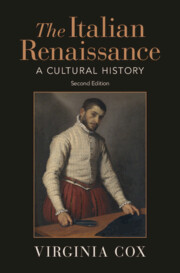Refine search
Actions for selected content:
194 results
Chapter 2 - The Renaissance and the Ancient
-
- Book:
- The Italian Renaissance
- Published online:
- 11 December 2025
- Print publication:
- 31 December 2025, pp 23-64
-
- Chapter
- Export citation
Chapter 3 - The Renaissance and the Modern
-
- Book:
- The Italian Renaissance
- Published online:
- 11 December 2025
- Print publication:
- 31 December 2025, pp 65-103
-
- Chapter
- Export citation

The Italian Renaissance
- A Cultural History
-
- Published online:
- 11 December 2025
- Print publication:
- 31 December 2025
Introduction: “An Imaginary Knowledge of the Perfect Truth” Meets the Risk-Uncertainty Conundrum
-
- Book:
- Entanglements in World Politics
- Published online:
- 27 November 2025
- Print publication:
- 11 December 2025, pp 1-30
-
- Chapter
-
- You have access
- Open access
- HTML
- Export citation
14 - Poetic Accumulation, Modernist Verse, and Imperial Capital
- from Part III - Figures, Movements, and Histories: 1900–1945
-
-
- Book:
- The Cambridge Companion to British Literature and Empire
- Published online:
- 20 November 2025
- Print publication:
- 04 December 2025, pp 202-215
-
- Chapter
- Export citation
Introduction
-
-
- Book:
- The Cambridge Companion to British Literature and Empire
- Published online:
- 20 November 2025
- Print publication:
- 04 December 2025, pp 1-16
-
- Chapter
- Export citation
Chapter 1 - Kant’s Invidious Humanism
-
- Book:
- Kant and Environmental Philosophy
- Published online:
- 01 November 2025
- Print publication:
- 20 November 2025, pp 13-46
-
- Chapter
- Export citation
Chapter 5 - Scientific Humanisms
- from Part II - Inspirations
-
-
- Book:
- Science and Humanism
- Published online:
- 09 October 2025
- Print publication:
- 23 October 2025, pp 107-125
-
- Chapter
-
- You have access
- Open access
- HTML
- Export citation
7 - The Religiously Unaffiliated and Seculars
- from Part II - Religious Traditions
-
- Book:
- Civil Religion and the Renewal of American Politics
- Published online:
- 09 October 2025
- Print publication:
- 23 October 2025, pp 133-154
-
- Chapter
- Export citation
Introduction
-
-
- Book:
- Science and Humanism
- Published online:
- 09 October 2025
- Print publication:
- 23 October 2025, pp 1-8
-
- Chapter
-
- You have access
- Open access
- HTML
- Export citation
Chapter 2 - Varieties of Philosophical Humanism and Conceptions of Science
- from Part I - Interrelations
-
-
- Book:
- Science and Humanism
- Published online:
- 09 October 2025
- Print publication:
- 23 October 2025, pp 36-59
-
- Chapter
-
- You have access
- Open access
- HTML
- Export citation
Chapter 3 - Scientism and the Limits of Objective Thinking
- from Part I - Interrelations
-
-
- Book:
- Science and Humanism
- Published online:
- 09 October 2025
- Print publication:
- 23 October 2025, pp 60-80
-
- Chapter
-
- You have access
- Open access
- HTML
- Export citation
Chapter 1 - What Is Science For?
- from Part I - Interrelations
-
-
- Book:
- Science and Humanism
- Published online:
- 09 October 2025
- Print publication:
- 23 October 2025, pp 11-35
-
- Chapter
-
- You have access
- Open access
- HTML
- Export citation

Science and Humanism
- Knowledge, Values, and the Common Good
-
- Published online:
- 09 October 2025
- Print publication:
- 23 October 2025
-
- Book
-
- You have access
- Open access
- Export citation
10 - Renaissance Men
- from Part III - Merchants in the Round
-
- Book:
- Making Merchants
- Published online:
- 19 September 2025
- Print publication:
- 09 October 2025, pp 145-164
-
- Chapter
- Export citation
A Humanist Reconquista: Hernando de Talavera’s Pedagogy of Good Manners and His Residential School for Morisco Boys
-
- Journal:
- History of Education Quarterly / Volume 65 / Issue 4 / November 2025
- Published online by Cambridge University Press:
- 30 September 2025, pp. 498-516
- Print publication:
- November 2025
-
- Article
- Export citation
Chapter 2 - Funding Utopia
-
- Book:
- Security, Fiscal Policy, and Sovereignty in Renaissance English Literature
- Published online:
- 04 September 2025
- Print publication:
- 18 September 2025, pp 32-57
-
- Chapter
- Export citation
African Studies Keyword: Human
-
- Journal:
- African Studies Review / Volume 68 / Issue 2 / June 2025
- Published online by Cambridge University Press:
- 18 July 2025, pp. 338-359
-
- Article
-
- You have access
- Open access
- HTML
- Export citation
2 - Mere Christianisation
-
- Book:
- Silence of the Gods
- Published online:
- 19 June 2025
- Print publication:
- 19 June 2025, pp 114-162
-
- Chapter
- Export citation
Chapter 4 - Humanism and Naturalism in the Paris Manuscripts
-
- Book:
- Karl Marx and the Actualization of Philosophy
- Published online:
- 17 April 2025
- Print publication:
- 24 April 2025, pp 82-105
-
- Chapter
- Export citation
